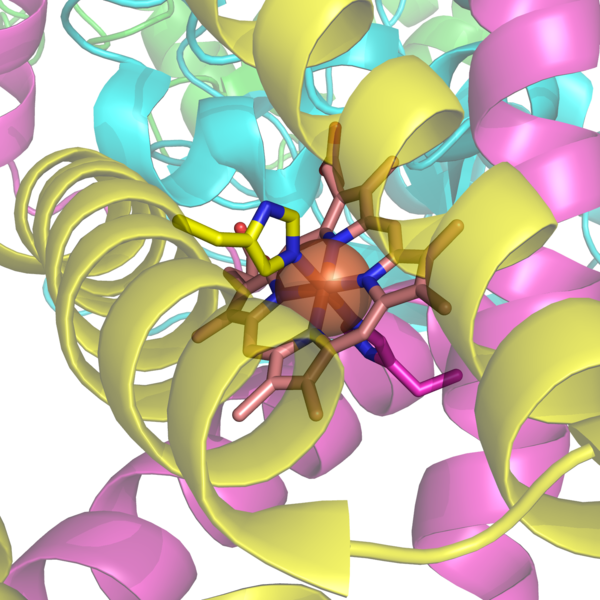Cofactor (biochemistry)
Editor-In-Chief: C. Michael Gibson, M.S., M.D. [1]

A cofactor is a non-protein chemical compound that is bound (either tightly or loosely) to an enzyme and is required for catalysis.[1] They can be considered "helper molecules/ions" that assist in biochemical transformations. Certain substances such as water and various abundant ions may be bound tightly by enzymes, but are not considered to be cofactors since they are ubiquitous and rarely limiting. Some sources limit the use of the term "cofactor" to inorganic substances.[2][3]
Cofactors can be divided into two broad groups: coenzymes and prosthetic groups. Coenzymes are small organic non-protein molecules that carry chemical groups between enzymes. These molecules are not bound tightly by enzymes and are released as a normal part of the catalytic cycle. In contrast, prosthetic groups form a permanent part of the protein structure.
Apoenzymes and holoenzymes
An enzyme without a cofactor is referred to as an apoenzyme, and the completely active enzyme (in addition to the cofactor) is called a holoenzyme.
Apoenzyme + cofactor <=> Holoenzyme
Metal ion cofactors
Metal ions are common cofactors. In nutrition, the list of essential trace elements reflects their role as cofactors. This list includes manganese, iron, cobalt, nickel, copper, zinc, and molybdenum. Other organisms require additional metals, such as vanadium and tungsten. The study of these cofactors falls under the area of bioinorganic chemistry.
In many cases, the cofactor includes both an inorganic and organic component. One diverse set of examples are the haem proteins, which consists of a porphyrin ring coordinated to iron.
Cofactors and coenzymes
Cofactors vary in their location and the tightness of their binding to the host enzyme. When bound tightly to the enzyme, cofactors are called prosthetic groups. Loosely-bound cofactors typically associate in a similar fashion to enzyme substrates. These are better described as coenzymes, which are organic substances that directly participate as substrates in an enzyme reaction. Vitamins can serve as precursors to coenzymes (e.g. vitamins B1, B2, B6, B12, niacin, folic acid) or as coenzymes themselves (e.g. vitamin C).
See also
References
- ↑ de Bolster, M.W.G. (1997). "Glossary of Terms Used in Bioinorganic Chemistry: Cofactors". International Union of Pure and Applied Chemistry. Retrieved 2007-10-30.
- ↑ "coenzymes and cofactors". Retrieved 2007-11-17.
- ↑ "Enzyme Cofactors". Retrieved 2007-11-17.
External links
- Template:EMedicineDictionary
- Enzyme+cofactors at the US National Library of Medicine Medical Subject Headings (MeSH)
ca:Cofactor cs:Kofaktor (biochemie) de:Kofaktor (Biochemie) fa:کوفاکتور he:קו-פקטור lt:Kofaktorius